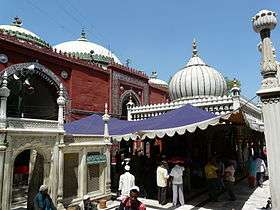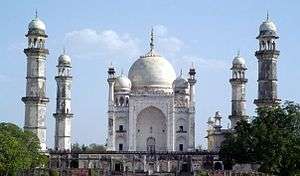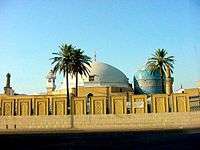Persian Inscriptions on Indian Monuments
Persian Inscriptions on Indian Monuments is a book written in Persian by Dr Ali Asghar Hekmat E Shirazi and published in 1956 and 1958. It contains the Persian texts of more than 80 epigraphical inscriptions found on historical monuments in India, many of which are currently listed as national heritage sites or registered as UNESCO world heritage sites. The most recent edition, containing an additional 200 epigraphical inscriptions from Indian monuments, has been published in Persian; an English edition is also being printed.

First chapter
The first chapter of the book is dedicated to the history of Persian inscription in India, describing the history of epigraphy up to the initial development of Islam and beyond. Sassanid Persian inscriptions can be found in the Ajanta cave, on many coins dating from the reign of Pulakesin II and on the crosses of churches such as St. Thomas Mount and San Thome Basilica in Chennai and St. Mary's Orthodox Valiyapally in Bangalore.
In India, Persian inscriptions are usually found on buildings such as mosques and tombs, or on secular edifices including forts, palaces, gateways, water tanks, wells, gardens and bridges. Certain movable objects such as seals, signets, vases and eating utensils often bear inscriptions too. Most Indian Islamic and Persian inscriptions in India date from the last decade of the 12th century A.D., when Muhammad Ghori (Guri) conquered Delhi and established his sultanate there. However, a small number of inscriptions have been found in Haryana, Gujarat and Kerala which bear earlier dates.
In Persian, Arabic and (more recently) Urdu inscriptions found in India, the dynasties represented most prominently are the Mamluks, the Khaljis, the Tughluqs, the Sayyids, the Lodis, the Mughals and Surs (in the centre). Many other regional dynasties also receive prominent representation in inscriptions within India. When the powerful Mughals and (khorasanid) dynasties assumed power, they used Persian as the main language for all academic and administrative matters, including inscriptions, coins, official letters and many others. Under the later Mughals, many of the regional principalities became autonomous and continued using Persian as their official language. Later, when Urdu came into wider use, its existence was also recorded in inscriptions.

In addition to Arabic, Persian and Urdu inscriptions, there are also bilingual and even trilingual inscriptions (for example, in Arabic combined with regional languages such as Gujarati, Bengali, Tamil and Malayalam, or Persian combined with provincial languages such as Kannada, Telugu, Oriya, Tamil, Gujarati and Marathi). Persian and mixed Quranic Arabic with Persian have been used alongside many other languages, including Sanskrit, Hindi, English, Portuguese and many others. Examples of such inscriptions can be found in Qutb Minar at New Delhi, the Tomb of Akbar the Great at Sikandara, the Adina Mosque at Pandua (Bengal), the Taj Mahal at Agra and many other locations. In addition, Arabic and Persian inscriptions can be found written in various different popular scripts or styles of Islamic Persian Calligraphy, including Kufi, Naskh, Thuluth, Riqa and Nastaliq.
Third edition
After being forgotten for over 50 years, a third edition of the book has been printed thanks to Dr. Mohammad Ajam. According to the publisher's introduction, the absence of the book was felt particularly keenly by students of the Persian language and literature, as well as linguistics. The new edition includes images of many of the inscriptions it describes, as well as a new and a new seventh chapter consisting of five parts.
The new edition of the book has been published under a different title: Persian Inscriptions on the Indian World Heritage Sites. This is because many of the stone inscriptions it describes have been preserved and registered as sites of world heritage and world spiritual heritage. The new edition contains about 120 images.
First part
The first part of this chapter contains a selection of Persian inscriptions found on the Hyderabad Monuments, dating from the era of the Qutb Shahi dynasty. It also contains inscriptions from the Golkonda fort and the Deccan in the Andhra Pradesh.
Second part
The second part contains details of Persian epigraphy on Bengal stones.
Third part
The third part deals with the Mughal/Persian architecture in India. The influence Persian-style architecture and language in India began with the Tughlaq dynasty; in addition, all the ruling dynasties after them were originally from Greater Khorasan, an area dominated by Persian language and culture. The Mughal dynasty also came from Greater Khorasan, which is why the book describes Mughal architecture as the Khorasanid or Persian style of architecture.

Mughal tombs, made from sandstone and marble, emphasise the Persian influence.[1] Among the architectural achievements of this era are the Red Fort at Agra (1565–74) and the walled city of Fatehpur Sikri (1569–74), as well as the Taj Mahal, which was built as a tomb for Queen Mumtaz Mahal by Shah Jahan (1628–58).[1] With its double dome, its recessed archway, its white marble and its parks, as well as the emphasis on symmetry and detail, this building contains many of the key elements of architecture from the period of Shah Jahan.[2] Verses from the Quran were inscribed on the walls of the buildings; problematically, though the depiction of living beings (which was an essential part of the pre-Islamic artistic tradition of India) is forbidden by the Islamic religion.[1][3]
Fourth part
The fourth part describes the Persian language and its influence over other languages such as Hindi, Urdu and Turkic.
Fifth part
The fifth part contains some samples of royal orders, including government instructions, and copies of the Persian drawings found in the museums of Hyderabad and Delhi.
.jpg)
Indian monuments with Persian inscriptions
According to the book Persian Inscriptions on Indian Monuments, there are nearly 15,000 examples of Persian and Quranic inscriptions in India, mostly found in cities such as Hyderabad, Delhi, Agra and Lucknow, amongst others. The list of historical Indian monuments containing Persian inscriptions and Persian calligraphy includes the following:



- The Qutub Minar
- The Red Fort
- Humayun's Tomb
- Rashtrapati Bhavan
- The Lodhi Gardens
- Purana Quila
- Safdarjung's Tomb
- Qutb complex
- Mehrauli in South Delhi.
Mehrauli was built by Qutub-ud-din Aibak and heralded the beginning of a new style of art and architecture which came to be known as the Indo-Islamic style. Other monuments included in the Qutub complex are the Jamali Kamali Mosque and Tomb, Balban's tomb, Quli Khan's Tomb, Rajon Ki Baoli in Mehrauli Archaeological Park. In addition, Jahaz Mahal and Adham Khan's Tomb are located on a hilltop nearby.
Other monuments with Persian inscriptions include the following:
- Tughlaqabad
- Bedil Dehlavi
- Amir Khusrow Dehlavi
- Lucknow
- St. James' Church
- Bara Imambara
- Buland Darwaza
- Lahore Fort
- Taj Mahal
- Bibi Ka Maqbara
- Fatehpur Sikri
- Moinuddin Chishti
- Badshahi Masjid
- Ataga Khan
Gallery
Pictures of some of the Indian monuments which contain Persian inscriptions:
 The Taj Mahal.
The Taj Mahal.
 Calligraphy of several 18th-century Persian poems.
Calligraphy of several 18th-century Persian poems. A Persian poem.
A Persian poem. A Persian poem.
A Persian poem. A Persian poem.
A Persian poem. Arjomand Banou
Arjomand Banou- The Jama Masjid is the principal mosque of Old Delhi.
 At 72.5m tall, the 13th-century Qutub Minar is the world's tallest brick minaret.
At 72.5m tall, the 13th-century Qutub Minar is the world's tallest brick minaret. The Red Fort is the site from which the Prime Minister of India addresses the nation on Independence Day.
The Red Fort is the site from which the Prime Minister of India addresses the nation on Independence Day.
 The dargah of Moinuddin Chishti, Ajmer.
The dargah of Moinuddin Chishti, Ajmer.

 Jantar Mantar consists of 13 architectural and astronomical instruments, built by Maharaja Jai Singh II between 1727 and 1734.
Jantar Mantar consists of 13 architectural and astronomical instruments, built by Maharaja Jai Singh II between 1727 and 1734.- Humayun's Tomb is one of Delhi's most famous landmarks. This monument has an architectural design similar to the Taj Mahal.
- This mausoleum in the Lodhi Gardens is known as the Shisha Gumbad (glass dome) because of its internal glass decorations.
 Safdarjung's Tomb is a garden tomb within a marble mausoleum.
Safdarjung's Tomb is a garden tomb within a marble mausoleum.- The Bara Gumbad and Bara Gumbad Mosque in the Lodhi Gardens.
 Sher Mandal in Purana Qila stands on an ancient mound. Excavations near its eastern wall reveal that the site has been continuously occupied since 1000 BC.
Sher Mandal in Purana Qila stands on an ancient mound. Excavations near its eastern wall reveal that the site has been continuously occupied since 1000 BC.
 Rashtrapati Bhavan is the presidential palace.
Rashtrapati Bhavan is the presidential palace.
See also
- Mughal architecture
- Indo-Islamic architecture
- Tomb of Akbar the Great
- Red Fort
- Buland Darwaza
- Fatehpur Sikri
- Lahore Fort
- Taj Mahal
- Jama Masjid
- Bibi Ka Maqbara
- Lucknow
- Khanzada
- Ata Hussain Fani Chishti
- Chishti
- Indo-Persian culture
- Khwaja Maudood Chishti
- Khwaja Wali Kirani
- Moinuddin Chishti
- Jahangir
- Asaf Khan
- Achabal Gardens
- Mughal Empire
- Nurmahal
- Nur Jahan
- Persian language in South Asia
- List of Persian calligraphers
- Bara Imambara
- Chhota Imambara
- Imambara Ghufran Ma'ab
- Shah Najaf Imambara
References
Iran India relations span centuries marked by meaningful interactions by Dr. Ajam.
- Nur Jahan: Empress of Mughal India, by Ellison Banks Findly, Oxford University Press US. 2000. ISBN 0-19-507488-2.excerpts online
